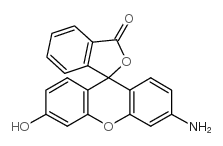M Benchaib, R Delorme, M Pluvinage, P A Bryon, C Souchier
Index: Histochem. Cell Biol. 106 , 253-256, (1996)
Full Text: HTML
Fluorescein isothiocyanate (FITC) is largely used in immunofluorescence methods. We propose to analyse the quality of some recent fluorochromes using image analysis. Fluorochromes tested include FITC and dichlorotriazinylaminofluorescein (DTAF), dipyrrometheneboron difluoride (BODIPY), Rhodol Green and cyanine 2. RAMOS cells were immunolabelled against the proliferating cell nuclear antigen (PCNA) revealed by the biotin-streptavidin technique. Slides were mounted in anhydrous glycerol or in buffered glycerol (pH 7.0 or pH 8.5). No antifading medium was added. Cell fluorescence emission intensity and bleaching characteristics were measured. Rhodol Green exhibited the highest fluorescence intensity and the best photobleaching resistance. Although BODIPY also resisted well during the photobleaching assay, its fluorescence intensity was weak. FITC, DTAF and cyanine 2 showed intermediate fluorescence intensity and a fast decay of fluorescence. Among the green emitting fluorochromes tested, Rhodol Green appeared to be the best.
| Structure | Name/CAS No. | Molecular Formula | Articles |
|---|---|---|---|
 |
Rhodol
CAS:3086-44-0 |
C20H13NO4 |
|
Construction of a library of rhodol fluorophores for develop...
2010-02-05 [Org. Lett. 12 , 496-499, (2010)] |
|
Toxicity of organic fluorophores used in molecular imaging: ...
2009-12-01 [Mol. Imaging 8 , 341-354, (2009)] |
|
Fluorescent rhodol derivatives: versatile, photostable label...
1992-12-01 [Anal. Biochem. 207 , 267-279, (1992)] |
Home | MSDS/SDS Database Search | Journals | Product Classification | Biologically Active Compounds | Selling Leads | About Us | Disclaimer
Copyright © 2024 ChemSrc All Rights Reserved